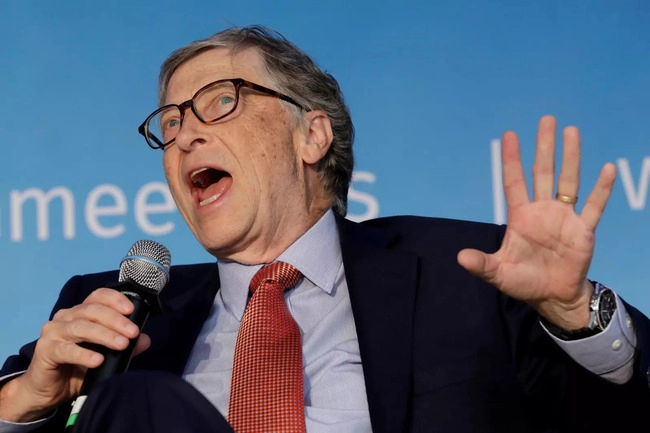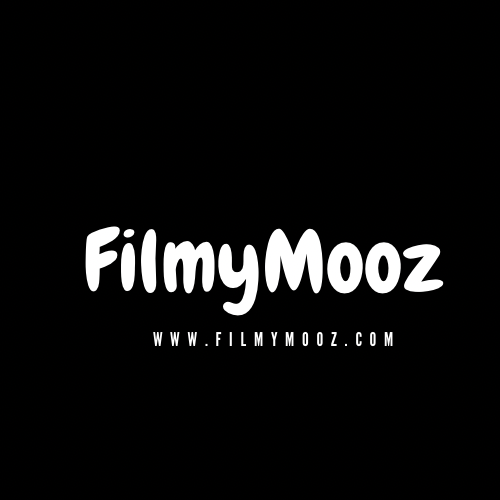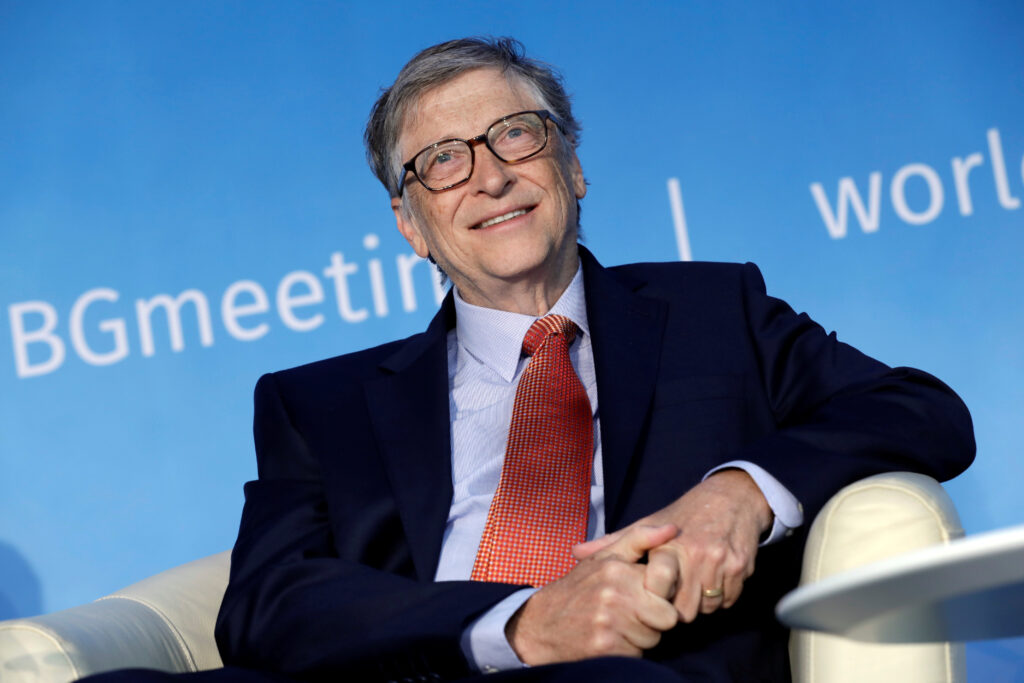
William Henry Gates III (born October 28, 1955) is an American business magnate, software developer, investor, author, and philanthropist. He is a co-founder of Microsoft, along with his late childhood friend Paul Allen. During his career at Microsoft, Gates held the positions of chairman, chief executive officer (CEO), president and chief software architect, while also being the largest individual shareholder until May 2014. He was a major entrepreneur of the microcomputer revolution of the 1970s and 1980s.
| Born | William Henry Gates III October 28, 1955 (age 67) Seattle, Washington, U.S. |
| Education | Harvard University (dropped out) |
| Occupation | Software developer investor entrepreneur |
| Known for | Co-founder of Microsoft and Bill & Melinda Gates Foundation |
| Board member of | Berkshire Hathaway Microsoft (former, both) |
| Spouse | Melinda French Gates (m. 1994; div. 2021) |
| Children | 3 |
| Parents | Bill Gates Sr. (father) Mary Maxwell (mother) |
| Awards | Presidential Medal of Freedom (2016) Hilal-e-Pakistan (2022) Knight Commander of the Order of the British Empire (2005) |
| Title | Co-chairperson of the Bill & Melinda Gates Foundation Chairman and founder of Branded Entertainment Network Chairman and founder of Cascade Investment Chairman and co-founder of TerraPower Founder of Breakthrough Energy Technology advisor of Microsoft. |
Early life
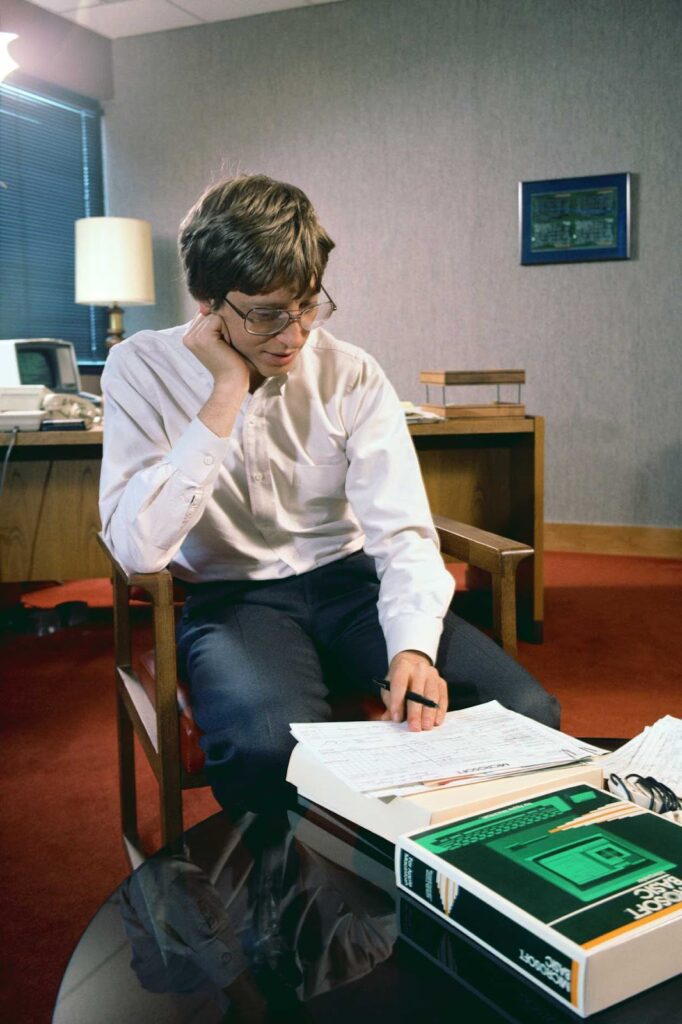
Bill Gates was born in Seattle, Washington on October 28, 1955. He is the son of William H. Gates Sr. (1925–2020) and Mary Maxwell Gates (1929–1994). His ancestry includes English, German, and Irish/Scots-Irish. His father was a prominent lawyer, and his mother served on the board of directors for First Interstate BancSystem and the United Way of America. Gates’s maternal grandfather was J. W. Maxwell, a national bank president. Gates has an older sister Kristi (Kristianne) and a younger sister Libby. He is the fourth of his name in his family but is known as William Gates III or “Trey” (i.e., three) because his father had the “II” suffix. The family lived in the Sand Point area of Seattle in a home that was damaged by a rare tornado when Gates was seven years old.
Early in his life, Gates observed that his parents wanted him to pursue a law career. When he was young, his family regularly attended a church of the Congregational Christian Churches, a Protestant Reformed denomination. Gates was small for his age and was bullied as a child. The family encouraged competition; one visitor reported that “it didn’t matter whether it was hearts or pickleball or swimming to the dock; there was always a reward for winning and there was always a penalty for losing”.
At 13, he enrolled in the private Lakeside prep school, where he wrote his first software program. When he was in the eighth grade, the Mothers’ Club at the school used proceeds from Lakeside School’s rummage sale to buy a Teletype Model 33 ASR terminal and a block of computer time on a General Electric (GE) computer for the students. Gates took an interest in programming the GE system in BASIC, and he was excused from math classes to pursue his interest. He wrote his first computer program on this machine, an implementation of tic-tac-toe that allowed users to play games against the computer. Gates was fascinated by the machine and how it would always execute software code perfectly. After the Mothers Club donation was exhausted, Gates and other students sought time on systems including DEC PDP minicomputers. One of these systems was a PDP-10 belonging to Computer Center Corporation (CCC) which banned Gates, Paul Allen, Ric Weiland, and Gates’s best friend and first business partner Kent Evans, for the summer after it caught them exploiting bugs in the operating system to obtain free computer time.
The four students formed the Lakeside Programmers Club to make money. At the end of the ban, they offered to find bugs in CCC’s software in exchange for extra computer time. Rather than using the system remotely via Teletype, Gates went to CCC’s offices and studied source code for various programs that ran on the system, including Fortran, Lisp, and machine language. The arrangement with CCC continued until 1970 when the company went out of business.
The following year, a Lakeside teacher enlisted Gates and Evans to automate the school’s class-scheduling system, providing them computer time and royalties in return. The duo worked diligently in order to have the program ready for their senior year. Towards the end of their junior year, Evans was killed in a mountain climbing accident, which Gates has described as one of the saddest days of his life. Gates then turned to Allen who helped him finish the system for Lakeside.
At 17, Gates formed a venture with Allen called Traf-O-Data to make traffic counters based on the Intel 8008 processor. In 1972, he served as a congressional page in the House of Representatives. He was a National Merit Scholar when he graduated from Lakeside School in 1973. He scored 1590 out of 1600 on the Scholastic Aptitude Tests (SAT) and enrolled at Harvard College in the autumn of 1973. He chose a pre-law major but took mathematics (including Math 55) and graduate level computer science courses. While at Harvard, he met fellow student Steve Ballmer. Gates left Harvard after two years while Ballmer stayed and graduated magna cum laude. Years later, Ballmer succeeded Gates as Microsoft’s CEO and maintained that position from 2000 until his resignation in 2014.
Gates devised an algorithm for pancake sorting as a solution to one of a series of unsolved problems presented in a combinatorics class by professor Harry Lewis. His solution held the record as the fastest version for over 30 years, and its successor is faster by only 2%. His solution was formalized and published in collaboration with Harvard computer scientist Christos Papadimitriou.
Gates remained in contact with Paul Allen and joined him at Honeywell during the summer of 1974. In 1975, the MITS Altair 8800 was released based on the Intel 8080 CPU, and Gates and Allen saw the opportunity to start their own computer software company Gates dropped out of Harvard that same year. His parents were supportive of him after seeing how much he wanted to start his own company. He explained his decision to leave Harvard: “if things hadn’t worked out, I could always go back to school. I was officially on leave.”
Microsoft
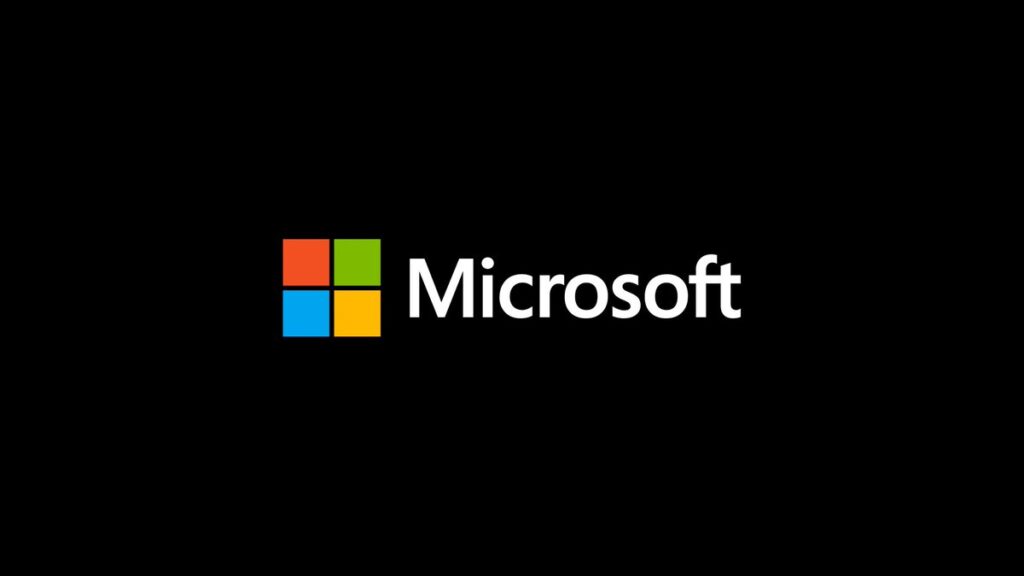
BASIC
Gates read the January 1975 issue of Popular Electronics which demonstrated the Altair 8800, and he contacted Micro Instrumentation and Telemetry Systems (MITS) to inform them that he and others were working on a BASIC interpreter for the platform. In reality, Gates and Allen did not have an Altair and had not written code for it; they merely wanted to gauge MITS’s interest. MITS president Ed Roberts agreed to meet them for a demonstration, and over the course of a few weeks they developed an Altair emulator that ran on a minicomputer, and then the BASIC interpreter. The demonstration was held at MITS’s offices in Albuquerque, New Mexico; it was a success and resulted in a deal with MITS to distribute the interpreter as Altair BASIC. MITS hired Allen, and Gates took a leave of absence from Harvard to work with him at MITS in November 1975. Allen named their partnership “Micro-Soft”, a combination of “microcomputer” and “software”, and their first office was in Albuquerque. The first employee Gates and Allen hired was their high school collaborator Ric Weiland. They dropped the hyphen within a year and officially registered the trade name “Microsoft” with the Secretary of the State of New Mexico on November 26, 1976. Gates never returned to Harvard to complete his studies.
Microsoft’s Altair BASIC was popular with computer hobbyists, but Gates discovered that a pre-market copy had leaked out and was being widely copied and distributed. In February 1976, he wrote an Open Letter to Hobbyists in the MITS newsletter in which he asserted that more than 90% of the users of Microsoft Altair BASIC had not paid Microsoft for it and the Altair “hobby market” was in danger of eliminating the incentive for any professional developers to produce, distribute, and maintain high-quality software. This letter was unpopular with many computer hobbyists, but Gates persisted in his belief that software developers should be able to demand payment. Microsoft became independent of MITS in late 1976, and it continued to develop programming language software for various systems. The company moved from Albuquerque to Bellevue, Washington on January 1, 1979.
Gates said he personally reviewed and often rewrote every line of code that the company produced in its first five years. As the company grew, he transitioned into a manager role, then an executive.
DONKEY.BAS, is a computer game written in 1981 and included with early versions of the PC DOS operating system distributed with the original IBM PC. It is a driving game in which the player must avoid hitting donkeys. The game was written by Gates and Neil Konzen.
IBM partnership

IBM, the leading supplier of computer equipment to commercial enterprises at the time, approached Microsoft in July 1980 concerning software for its upcoming personal computer, the IBM PC, after Bill Gates’s mother, Mary Maxwell Gates, mentioned Microsoft to John Opel, IBM’s CEO. IBM first proposed that Microsoft write the BASIC interpreter. IBM’s representatives also mentioned that they needed an operating system, and Gates referred them to Digital Research (DRI), makers of the widely used CP/M operating system. IBM’s discussions with Digital Research went poorly, however, and they did not reach a licensing agreement. IBM representative Jack Sams mentioned the licensing difficulties during a subsequent meeting with Gates and asked if Microsoft could provide an operating system. A few weeks later, Gates and Allen proposed using 86-DOS, an operating system similar to CP/M, that Tim Paterson of Seattle Computer Products (SCP) had made for hardware similar to the PC. Microsoft made a deal with SCP to be the exclusive licensing agent of 86-DOS, and later the full owner. Microsoft employed Paterson to adapt the operating system for the PC and delivered it to IBM as PC DOS for a one-time fee of $50,000.
The contract itself only earned Microsoft a relatively small fee. It was the prestige brought to Microsoft by IBM’s adoption of their operating system that would be the origin of Microsoft’s transformation from a small business to the leading software company in the world. Gates had not offered to transfer the copyright on the operating system to IBM because he believed that other personal computer makers would clone IBM’s PC hardware. They did, making the IBM-compatible PC, running DOS, a de facto standard. The sales of MS-DOS (the version of DOS sold to customers other than IBM) made Microsoft a major player in the industry. The press quickly identified Microsoft as being very influential on the IBM PC. PC Magazine asked if Gates was “the man behind the machine?”.
Gates oversaw Microsoft’s company restructuring on June 25, 1981, which re-incorporated the company in Washington state and made Gates the president and chairman of the board, with Paul Allen as vice president and vice chairman. In early 1983, Allen left the company after receiving a Hodgkin lymphoma diagnosis, effectively ending the formal business partnership between Gates and Allen, which had been strained months prior due to a contentious dispute over Microsoft equity. Later in the decade, Gates repaired his relationship with Allen and together the two donated millions to their childhood school Lakeside. They remained friends until Allen’s death in October 2018.
Windows
Microsoft and Gates launched their first retail version of Microsoft Windows on November 20, 1985, in an attempt to fend off competition from Apple’s MacintoshGUI, which had captivated consumers with its simplicity and ease of use. In August of the following year, the company struck a deal with IBM to develop a separate operating system called OS/2. Although the two companies successfully developed the first version of the new system, the partnership deteriorated due to mounting creative differences. The operating system grew out of DOS in an organic fashion over a decade until Windows 95, which hid the DOS prompt by default. Windows XP, released one year after Gates stepped down as Microsoft CEO, was the first to not be based on DOS.Windows 8.1 was the last version of the OS released before Gates left the chair of the firm to John W. Thompson on February 5, 2014.
Business ventures and investments
Gates has a multi-billion dollar investment portfolio with stake in various sectors and has participated in several entrepreneurial ventures beyond Microsoft, including:
- AutoNation, automotive retailer that Gates has a 16% stake in trading on the NYSE.
- bgC3 LLC, a think-tank and research company founded by Gates.
- Canadian National Railway (CN), a Canadian Class I freight railway. As of 2019, Gates is the largest single shareholder of CN stock.
- Cascade Investment LLC, a private investment and holding company incorporated in the United States, founded and controlled by Gates and headquartered in Kirkland, Washington.
- Gates is the top private owner of farmland in the United States with landholdings owned via Cascade Investment totalling 242,000 acres across 19 states. He is the 49th largest private owner of land in the US.
- Carbon Engineering, a for-profit venture founded by David Keith, which Gates helped fund It’s is also supported by Chevron Corporation and Occidental Petroleum.
- SCoPEx, Keith’s academic venture in “sun-dimming” geoengineering, which Gates provided most of the $12 million for.
- Corbis (originally named Interactive Home Systems and now known as Branded Entertainment Network), a digital image licensing and rights services company founded and chaired by Gates.
- EarthNow, Seattle-based startup company aiming to blanket the Earth with live satellite video coverage. Gates is a large financial backer.
- Eclipse Aviation, a defunct manufacturer of very light jets. Gates was a major stake-holder early on in the project.
- Impossible Foods, a company that develops plant-based substitutes for meat products. Some of the $396 million Patrick O. Brown collected for his business came from Gates around 2014 to 2017.
- Ecolab, global provider of water, hygiene and energy technologies and services to the food, energy, healthcare, industrial and hospitality markets. Combined with the shares owned by the Foundation, Gates owns 11.6% of the company. A shareholder agreement in 2012 allowed him to own up to 25% of the company, but this agreement was removed.
- ResearchGate, a social networking site for scientists. Gates participated in a $35 million round of financing along with other investors.
- TerraPower, a nuclear reactor design company co-founded and chaired by Gates, which is developing next generation traveling-wave reactor nuclear power plants in an effort to tackle climate change.
- Breakthrough Energy Ventures, a closed fund for wealthy individuals who seek ROI on a 20-year horizon (see next section), which “is funding green start-ups and a host of other low-carbon entrepreneurial projects, including everything from advanced nuclear technology to synthetic breast milk.” It was founded by Gates in 2015.
- Ginkgo Bioworks, a biotech startup that received $350 million in venture funding in 2019, in part from Gates’s investment firm Cascade Investment.
- Luminous Computing, a company that develops neuromorphic photonic integrated circuits for AI acceleration.
- Mologic, British diagnostic technology company that Gates purchased, along with the Soros Economic Development Fund, “which has developed 10-minute Covid lateral flow tests that it aims to make for as little as $1.”
Personal donations
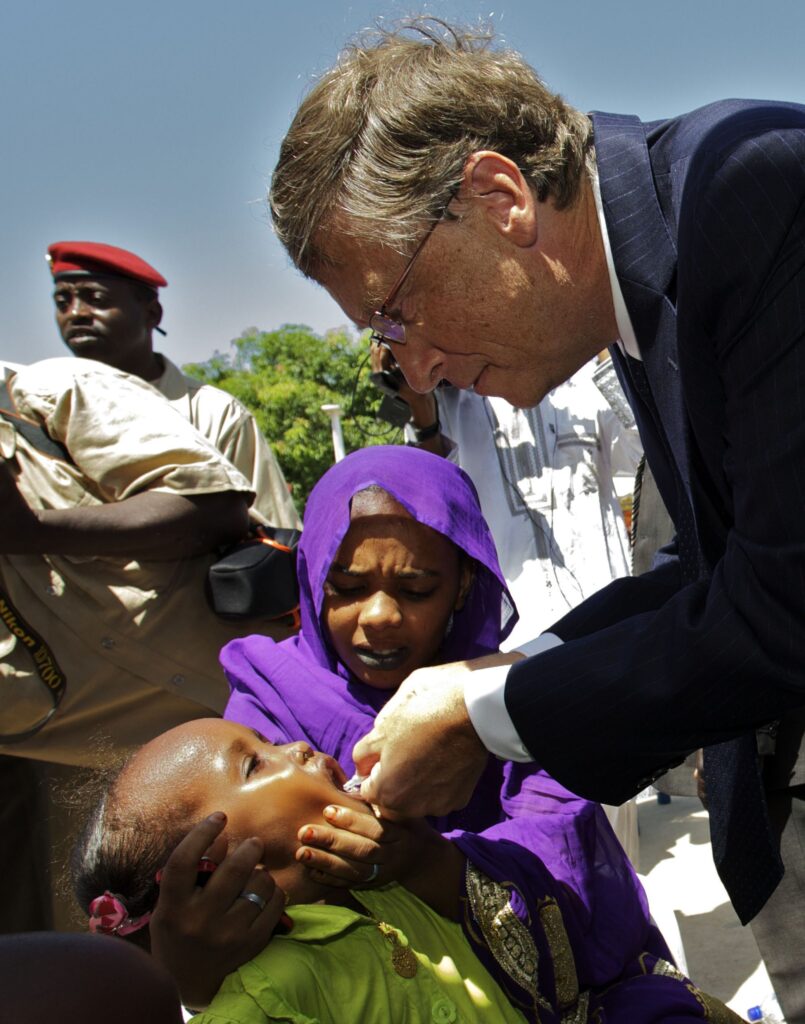
Melinda Gates suggested that people should emulate the philanthropic efforts of the Salwen family, who sold their home and gave away half of its value, as detailed in their book, The Power of Half. Gates and his wife invited Joan Salwen to Seattle to speak about what the family had done, and on December 9, 2010, Bill and Melinda Gates and investor Warren Buffett each signed a commitment they called the “Giving Pledge”, which is a commitment by all three to donate at least half of their wealth, over the course of time, to charity.
Gates has also provided personal donations to educational institutions. In 1999, Gates donated $20 million to the Massachusetts Institute of Technology for the construction of a computer laboratory named the “William H. Gates Building” that was designed by architect Frank Gehry. While Microsoft had previously given financial support to the institution, this was the first personal donation received from Gates.
The Maxwell Dworkin Laboratory of the Harvard John A. Paulson School of Engineering and Applied Sciences is named after the mothers of both Gates and Microsoft President Steven A. Ballmer, both of whom were students (Ballmer was a member of the school’s graduating class of 1977, while Gates left his studies for Microsoft), and donated funds for the laboratory’s construction. Gates also donated $6 million to the construction of the Gates Computer Science Building, completed in January 1996, on the campus of Stanford University. The building contains the Computer Science Department and the Computer Systems Laboratory (CSL) of Stanford’s Engineering department.
Since 2005, Gates and his foundation have taken an interest in solving global sanitation problems. For example, they announced the “Reinvent the Toilet Challenge”, which has received considerable media interest. To raise awareness for the topic of sanitation and possible solutions, Gates drank water that was “produced from human feces” in 2014 – it was produced from a sewage sludge treatment process called the Omni Processor. In early 2015, he also appeared with Jimmy Fallon on The Tonight Show and challenged him to see if he could taste the difference between this reclaimed water or bottled water.
In November 2017, Gates said he would give $50 million to the Dementia Discovery Fund, a venture capital fund that seeks treatment for Alzheimer’s disease. He also pledged an additional $50 million to start-up ventures working in Alzheimer’s research. Bill and Melinda Gates have said that they intend to leave their three children $10 million each as their inheritance. With only $30 million kept in the family, they are expected to give away about 99.96% of their wealth. On August 25, 2018, Gates distributed $600,000 through his foundation via UNICEF which is helping flood affected victims in Kerala, India.
In June 2018, Bill Gates offered free ebooks, to all new graduates of U.S. colleges and universities, and in 2021, offered free ebooks, to all college and university students around the world. The Bill And Melinda Gates Foundation partially funds OpenStax, which creates and provides free digital textbooks.
Charity sports events
On April 29, 2017, Gates partnered with Swiss tennis legend Roger Federer in playing in the Match for Africa 4, a noncompetitive tennis match at a sold-out Key Arena in Seattle. The event was in support of the Roger Federer Foundation’s charity efforts in Africa. Federer and Gates played against John Isner, the top-ranked American player for much of this decade, and Mike McCready, the lead guitarist for Pearl Jam. The pair won the match 6 games to 4. Overall, they raised $2 million for children in Africa. The following year, Gates and Federer returned to play in the Match for Africa 5 on March 5, 2018, at San Jose’s SAP Center. Their opponents were Jack Sock, one of the top American players and a grand slam winner in doubles, and Savannah Guthrie, a co-anchor for NBC’s Today show. Gates and Federer recorded their second match victory together by a score of 6–3 and the event raised over $2.5 million.
Books
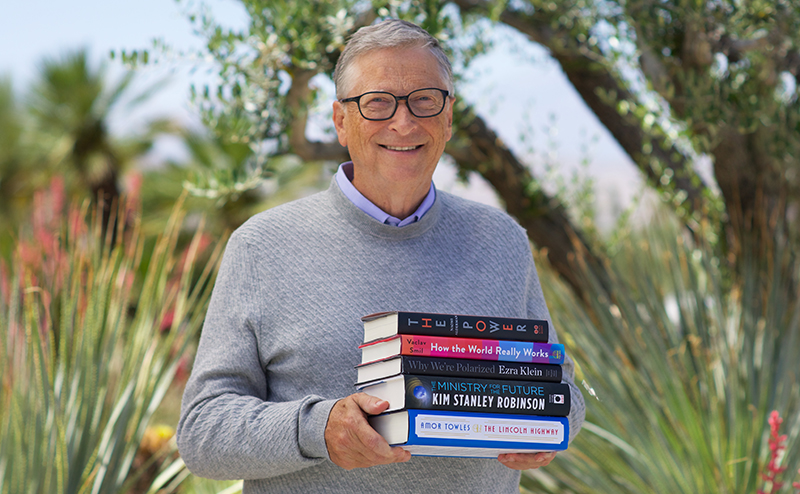
Gates has written four books:
- The Road Ahead, written with Microsoft executive Nathan Myhrvold and journalist Peter Rinearson, was published in November 1995. It summarized the implications of the personal computing revolution and described a future profoundly changed by the arrival of a global information superhighway.
- Business @ the Speed of Thought was published in 1999, and discusses how business and technology are integrated, and shows how digital infrastructures and information networks can help to get an edge on the competition.
- How to Avoid a Climate Disaster (February 2021) presents what Gates learned in over a decade of studying climate change and investing in innovations to address climate problems.
- How to Prevent the Next Pandemic (April 2022) details the COVID-19 pandemic and proposes a “Global Epidemic Response and Mobilization” (GERM) team with annual funding of $1 billion, under the auspices of the WHO.



